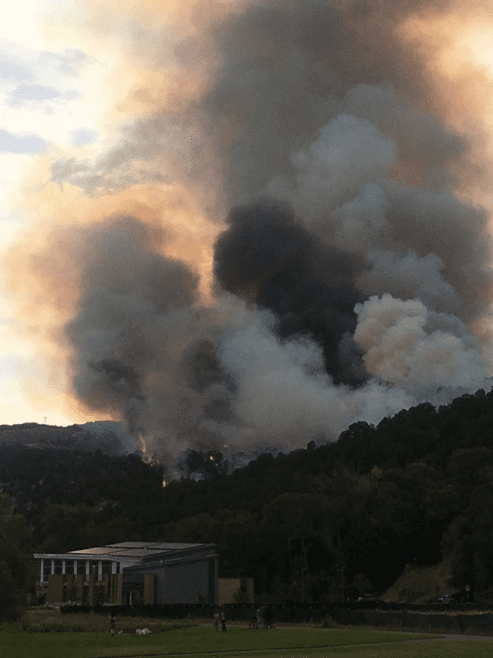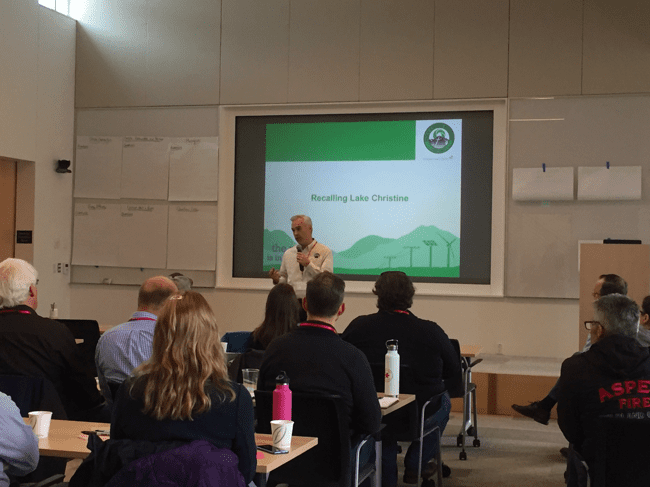
Energy Resilience in the Roaring Fork Valley
On the evening of July 3, 2018, a wildfire broke out a half mile from the Rocky Mountain Institute office in Basalt, Colorado, in the heart of the Roaring Fork Valley. This fire—dubbed the Lake Christine Fire—spread to engulf more than 12,500 acres and came within minutes of shutting down power to the upper Roaring Fork Valley. Three out of four transmission lines running into Aspen went down; had the fourth line gone down, it could have been days to weeks before power was restored. The fire started right in time for peak tourist season, as thousands of visitors filled the valley for Fourth of July week—a factor that would have exacerbated the impact of an extended power outage.
 photo credit: Matt Bennett, Glenwood Post Independent
photo credit: Matt Bennett, Glenwood Post Independent
This event served as an important reminder to stakeholders across the valley of the importance of resilience planning. Motivated by this close call, Holy Cross Energy (HCE)—the local electric cooperative which serves RMI’s Basalt office and nearly 45,000 other members across the Roaring Fork and Eagle River Valleys—has partnered with RMI to explore solutions for increasing energy resilience in the communities it serves.
Yet wildfires are just one of a multitude of threats to the energy system—including other extreme weather events, cybersecurity threats, and physical attacks—that are motivating communities to consider and invest in additional resilience efforts. At a time when energy resilience is top of mind for many communities around the globe, the outcomes of the collaboration between HCE and RMI can serve as a useful template for similarly vulnerable communities outside the Roaring Fork Valley.
Roaring Fork Valley Stakeholders Come Together to Identify Community-Based Energy Resilience Solutions
The HCE and RMI effort takes place in the context of myriad ongoing efforts from HCE, its members, and other partners to mitigate and adapt to fire and other resilience risks. HCE, for its part, is investing in new technologies and infrastructure upgrades to harden its transmission system, among other steps to reduce fire risk and build resilience. In parallel, many HCE members and other Roaring Fork Valley community members have already invested in backup generators that can power their critical facilities in the event of an extended outage.
RMI’s collaboration with HCE aims to capture the synergies between these previously unconnected efforts and lay the groundwork for resilience projects that leverage the contributions of both the utility and its members. RMI and HCE are working together to surface and explore stakeholder priorities regarding resilience, identify promising technical and economic opportunities, and lay the groundwork for near-term, collaborative action. Over the past several months, RMI has been engaging with community organizations including health and emergency services, city and county governments, school districts, transportation providers, and private businesses to understand current electricity use priorities, any backup plans already in place, and opportunities for improvement in partnership with HCE or other community members.
On April 3, 2019, representatives from these organizations joined staff and leadership from RMI and HCE for a workshop focused on finding collaborative solutions for Upper Valley resilience issues. Through a series of presentations, discussions, and facilitated working sessions, participants developed a shared understanding of critical electricity-dependent services and explored options for electricity resilience solutions.
By the end of the day, several ideas emerged as potential multistakeholder projects ripe for further investigation and near-term action:
- Community microgrids
Microgrids would allow each community/neighborhood to retain power independently in the case of a grid power outage. This project will scope community-level microgrids, likely focusing initially on designing a pilot microgrid in a small region that already contains generation assets.
- Bulk supply resilience
There are a number of contractual and operational barriers that make it complicated and difficult for HCE and the City of Aspen to share electricity generation resources, even if one of the utilities has an outage that could be supported by the other’s resources and infrastructure. This initiative will involve HCE and the City of Aspen working together with their wholesale power suppliers to put in place formal arrangements to address contingent energy supply during emergencies.
- Mobile generation fleet/refuge center backup supply
Most refuge/evacuation centers—particularly school campuses—as well as “secondary critical loads” do not have dedicated backup power. This working group will develop two solutions: 1) creating an inventory of mobile generators and a plan for their deployment to these secondary critical loads during outages, and 2) procuring electric school buses that could be used as backup power for schools.
- Critical services energy assessment
Energy efficiency is an important first step to any subsequent resilience investments. This project will involve designing a process for assessing the energy use of critical services and allow these service providers to identify the most effective energy efficiency measures through a cost/savings/benefits framework.
- Gas pump resilience
When the power goes down, so does the ability to pump gas at most gas stations. This project will explore the use of dedicated solar and battery storage as backup power for gas pumps to allow customers to continue to pump gas during an outage, which could be critical in case of an evacuation.
- Woody Creek solar
There is a proposed solar farm to be developed in the Woody Creek region of the Roaring Fork Valley. This project would explore opportunities to design the Woody Creek solar facility to provide resilient community benefit, such as through the inclusion of battery storage or a microgrid.
- Building codes
Improving the energy efficiency of buildings would lessen the electricity needed to keep them up and running during an emergency or outage. This proposed working group would investigate opportunities to update building codes to improve critical end-use efficiency and resilience.
Finding Opportunities for “Blue Sky” Value from “Black Sky” Resources
A key question that was raised throughout the workshop is how HCE, partner organizations, and communities can invest in technologies and resources that will support them in the event of an emergency, while also providing benefit throughout the year. Many first responders and other community organizations reported having diesel or natural gas backup generators; while this is an effective and simple way of ensuring the lights stay on, most stakeholders reported they only get used around 30 minutes total in a typical year.
Energy efficiency and solar coupled with storage are both examples of resilience options that can provide benefit year-round. While end-use efficiency does not in itself provide power during an outage, it allows for more critical services to be delivered with limited generation capacity. Year-round, increased efficiency lowers energy demand and costs. On-site solar and storage can provide backup power when the grid goes down, and don’t rely on diesel or natural gas supplies to continue functioning. The rest of the year, these systems can operate connected to the grid, providing value by reducing energy bills for the system owners and potentially providing grid services such as frequency regulation.
This core concept—the idea that resilience is not just about emergency preparedness but also should take into account a range of considerations from blue sky to black sky days—was reflected in many of the ideas that were developed at the workshop, several of which focus on efficiency, solar, and battery storage.
What’s Next?
Many of the ideas that emerged at the workshop—outlined above—will be advanced through multistakeholder working groups throughout May and June. Each working group will be led by a champion with support from RMI and HCE staff. In mid-June, participants will come back together as a group to present their progress and receive feedback from one another.
Throughout RMI’s work around the globe, the best and most effective solutions involve multiple perspectives and stakeholder voices. Through this collaborative effort, the Roaring Fork Valley can harness the collective creativity, expertise, and resources of its vibrant community to arrive at innovative solutions and build a more resilient home for its residents and visitors.
If you’re interested in being kept in the loop with project updates and outcomes, contact Emily Goldfield at egoldfield@rmi.org.
